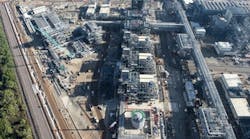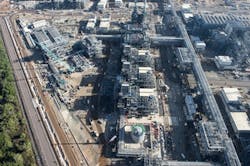The advent of new feedstocks, the increasing interest in making batch/specialty chemicals, the growth of cloud-based applications and the need for broader training strategies are creating greater-than-ever opportunities at chemical makers for training simulators, say vendors of such technology.
One vendor benefitting from these opportunities is AVEVA, Lake Forest, Calif., which earlier this year completed its merger with Schneider Electric’s industrial software business.
Enterprise-wide needs increasingly drive the demand for operator training simulators (OTSs), according to Ian Willetts, AVEVA’s vice president, simulation & training. “It’s becoming more operator and training simulators,” he says.
Willetts cites a recent example of this at a project carried out for Kuwait Oil Company (KOC), Ahmadi, Kuwait. For a number of years the company had used SimSci software to train control room workers. However, the need to improve overall operator training and also to effectively capture and transfer knowledge from older staff led KOC to select SimSci’s EYESIM immersive virtual reality technology. The new training system connects all plant personnel with a high-fidelity 3D process simulation and virtual walk-through plant environment.
KOC already is seeing the results both in terms of fewer accidents and avoidance of costly plant shutdowns, notes Willetts.
While the “graying” workforce in developed economies presents one demographic challenge for operating companies, another comes from the young, largely unskilled workforces found in many less-developed economies.
“For example, a grassroots refinery in Nigeria needs trained staff to work not only as operators but also in maintenance, field engineering, [and] process engineering — in fact at every level in the facility. So, there is also a big new push on here for enterprise-wide training that brings simulation to a much broader audience,” he explains.
The cloud also is positively impacting simulator training. A number of chemical companies, says Willets, are pursuing a strategy already taken by Arizona Public Service, the largest electrical utility in that state. Its generating plants are hundreds of miles apart but adopting a fully cloud-accessed OTS has eliminated the need for operations staff to travel for training sessions. In addition, the entire training system powers up in just five minutes, so staff can begin training immediately.
“Once you open the door to a platform on the cloud, you can develop an open system which allows people from all across an enterprise to access the training they need,” he adds.
A similar approach taken by Paris-based refiner and petrochemicals producer Total means that any engineer within the company can launch training simulations on both processes and equipment using dynamic simulation at that person’s siteno matter where in the world it’s located (Figure 1).
Figure 1. Any engineer at Paris-based company can launch training simulation for process or equipment. Source: Total Group.
“One specific model we delivered for Total concerns compressors. They are such a crucial piece of equipment and a perfect example of something that must be thoroughly understood by new staff. The simulator is accessed through the company’s learning management system, which Total now wants to open out to include other equipment. We are pursuing very similar projects with other process customers, too,” comments Willetts.
Changing raw materials have opened up other opportunities. In the U.S., for example, the move to shale gas and natural gas liquids as feedstocks means that operators must have expert feedstock knowledge.
“Here, we have integrated FMC Technologies’ Spyro furnace design and optimization software into our OTS, something that has never been done successfully before. It gives our users a much fuller understanding of feedstock parameters,” he adds.
AVEVA also is pushing the importance of best practices via an experienced training services team. The goal is to help customers map its technology onto their own competency frameworks. This is critical for customer success, says Willetts, who notes that without it outcomes provide much less value. “It’s a key differentiator for us and something we are carrying out for multiple clients.”
The Value Proposition
Effective training prevents accidents from happening and reduces process challenges such as bottlenecks and equipment failures — so OTSs provide real value, stresses Dinu Ajikutira, senior director of product marketing at AspenTech, Bedford, Mass.
The technology has a proven track record, he says, with savings of up to $15 million per project that embraces an OTS.
As an example of such benefits, he cites a project with CEPSA, Madrid, which has two manufacturing sites, one in Spain and the other in China.
“They have about 46 operators at the two locations and wanted them to have identical training, for example at startup and shutdown, so as to develop similar skill sets and then be interchangeable between the two plants,” Ajikutira explains.
AspenTech used HYSYS simulation software and the distributed control system operator workstations in the plants’ control rooms. These were then connected to a hyperdynamic model in the Aspen OTS framework and 50 different disturbance scenarios were created.
“For the operators, it meant that their training experiences were exactly as if operating one of the plants. We spent around 2,000 hours on training with them. CEPSA has since reported an increase in safety and a reduction in off-spec products at the two plants — although they are not keen to put a dollar value on these savings,” he notes.
One of AspenTech’s goals on this and similar projects is to promote an attitude of lifecycle dynamic modeling that leverages the same dynamic model for multiple applications. “Most companies do not focus on training the client on the dynamic model and instead focus on just delivering the turnkey OTS,” emphasizes Ajikutira.
Another increasingly common use is after acquisitions or mergers where the enlarged company wants all the incoming operations staff to work to exactly the same standard operating procedures as its existing operators. Overall, the expectation these days is that new operators — whatever their backgrounds — should be up and running very, very quickly, he says.
Altered operational scenarios also open up opportunities. “In the real world, processes are changing — and more so than ever before. The move to shale gas as a feedstock is one example, but there is also the rise of batch/specialty chemical manufacturing. This is where the big margins are, but the products change rapidly in terms of raw materials, volume, product spec, etc., depending on demand. So, the OTS has to be bang up to date. There’s absolutely no point in being trained on the wrong process,” cautions Ajikutira.
He also points to the importance of the ongoing sustainability of an OTS technology during new builds: “There are many tools utilized throughout the entire project lifecycle to satisfy key requirements. By increasing our focus on the dynamic model lifecycle, we will provide tight integration between our core products at all project stages. Utilizing the same model from the beginning to end of the project lifecycle will reduce the amount of rework required and increase collaboration between different teams.”
Achieving Greater Success
Lifecycle dynamic simulation is the key to achieving peak performance, believes Martin Berutti, vice president of process simulation, Emerson Automation Solutions, Chesterfield, Mo. “As the chemical industry has evolved from engineer-driven to operations-driven, shrinking workforces and global competition have pushed chemical organizations to run leaner and more efficiently. Plants want to make changes, but the risk of downtime frequently keeps them from making the changes that can deliver peak performance. Lifecycle dynamic simulation solves this problem by allowing organizations to better understand how operations and control strategies can be improved without requiring a shutdown or risking processes critical to the plant’s bottom line.”
Emerson incorporates its Mimic simulation and AspenTech’s HYSYS Dynamics to deliver lifecycle dynamic simulation via DeltaV Simulate or third-party control systems; this enables seamless leveraging from project design to successful operator training and long-term plant control and production (Figure 2).
Figure 2. Dynamic model helps in project design, operator training, and long-term plant control and production. Source: Emerson Automation Solutions.
Part of Emerson’s strategy is to make the benefits of lifecycle dynamic simulation—using the digital twin approach—accessible and cost-effective regardless of a company’s use case. Mimic’s selective fidelity lets an organization move from low to medium to high fidelity to meet the specific and changing needs of its applications, cutting the cost of entry and the total cost of ownership.
In addition, a company using AspenTech’s HYSYS and HYSYS Dynamics for modeling quickly can move to having a digital twin built at a low lifecycle cost, he says. This allows an organization to leverage existing data from process design for the OTS and then operations improvement, delivering value and return on investment across the plant lifecycle.
Using this approach, manufacturers throughout the chemical industry are reaping the benefits of lifecycle dynamic simulation, notes Berutti.
For example, he cites the recent case of a refiner that had great success with its OTS during a hydrocracker project. However, during training, the simulation revealed a problem with a feed to the hydrocracker’s main fractionator. Upon investigation, this problem led directly to a process design issue that would have required a shutdown and change of piping directly after startup. “The project team caught the problem in time and was able to fix it before startup, saving the company millions of dollars,” he says.
Similarly, an OTS used to deliver training to new operators on a greenfield project for an ammonia plant turned up a severe safety problem. While testing a training scenario, the digital twin predicted an explosive condition in the primary reformer. “When trainers notified the customer, the plant engineer realized that there was a process engineering issue missed in engineering design, leaving the organization with a serious explosion risk and putting personnel and the plant in jeopardy,” Berutti explains. The company was able to fix the problem before startup and could move forward confident that no further issues would escape notice.
The benefits of lifecycle dynamic simulation extend beyond greenfield projects, he stresses. For example, a multinational chemical manufacturer needed to perform a shutdown procedure but hadn’t run either a startup or shutdown in a very long time. Using dynamic simulation to train for the procedure, the organization discovered that interlocks in the control system made startup almost impossible. “Had the organization performed a shutdown without realizing this problem, it would have suffered an extended outage that would have potentially cost millions of dollars. By catching the interlock problem with the simulator, the organization was able to keep its scheduled outage on schedule,” he notes.
In another case, a specialty chemical plant that was underperforming due to poor batch control design wanted to develop, test and fine-tune new designs without impacting production. Its engineers initially dismissed the idea of simulation as a solution due to anticipated high costs of high-fidelity models. However, the team discovered that selective model fidelity available with lifecycle dynamic simulation would allow use of medium-fidelity modeling for the entire plant, with high fidelity necessary only for the reaction models. “The cost savings of selective fidelity coupled with the production benefits prompted the organization to pursue the option of implementing simulation organization-wide,” says Berutti.
Dutch Development
Long-established vendors don’t have the market to themselves. For instance, one newcomer, virtual reality development and performance data analytics specialist Serious VR, Enschede, The Netherlands, recently started working with AkzoNobel, Amsterdam, on the development of virtual training applications using Serious’ in-house virtual reality (VR) technology. This follows a two-year period of development with a sister company on how to do use 3D animations in an e-learning environment to ensure that operators fully understand how to carry out critical procedures on chemical plants.
“One of the most important reasons that our clients work with us and with the VR technology is because drastic cost reductions can be made, especially in the time spent by operators on plant maintenance or other technical procedures. This means the ROI [return on investment] can be calculated by measuring the extra uptime in the production, resulting in a higher production or lower plant downtime. The safety aspect, i.e., reducing incidents, is also a critical reason to start using both VR and augmented reality (AR) in operator training,” explains company co-founder Ton Kuper.
As well as being flexible — operators can be trained anywhere at any time — Serious VR’s learning management system captures training data that allow measuring and optimizing the progress of operators.
“Both VR and AR technologies will find their way in a training environment because lots of procedures need both approaches to get the best possible output of how operators successfully do their job,” Kuper believes.





